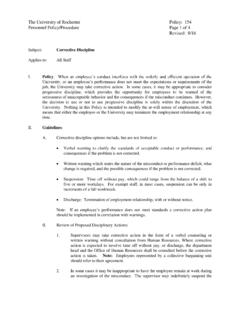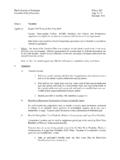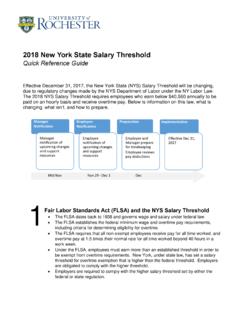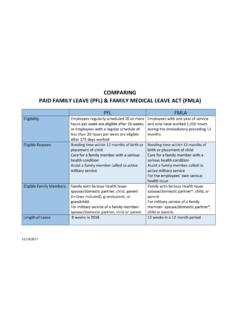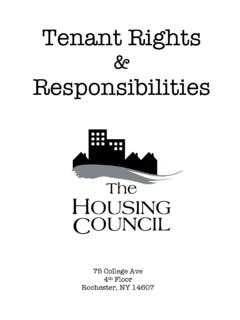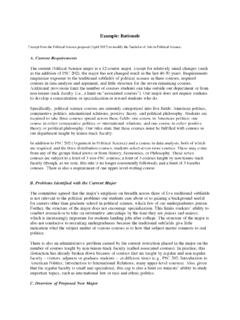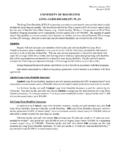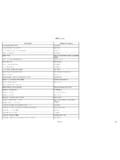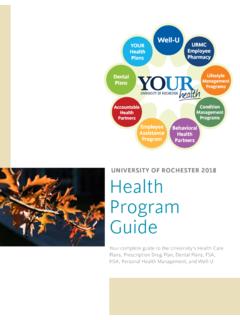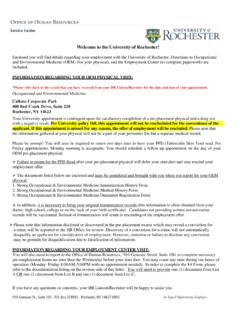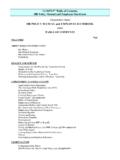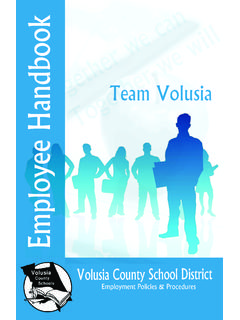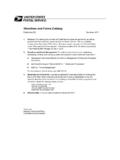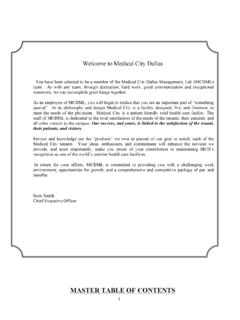Transcription of Faculty Handbook - rochester.edu
1 Faculty Handbook UNIVERSITY OF rochester . UPDATED: MAY 2017. Table of Contents Table of Contents ..1. I. Introduction ..4. II. Organization ..6. A. Trustees ..6. 1. The Committees of the Board ..6. B. Central 1. President ..6. 2. Provost ..7. 3. Vice Presidents and Other C. Schools of the University ..7. D. Graduate Studies ..7. E. Faculty Senate ..7. F. Faculty Governance ..8. G. Intercessors ..9. III. University Policies ..10. A. Affirmative Action, Equal Employment Opportunity, and Discrimination and Harassment ..10. B. Conflicting Employment Relationships (Nepotism) ..11. C. Intimate Relationships ..11. D. Copyright and Fair Use Policy ..12. E. Disability Accommodation ..12. F. Dissent and Public Order ..12. 1. Standards of Conduct ..12. 2. Procedures for Addressing Violations ..13. G. Distinguished Visitors .. 14. H. Drugs ..14. I. Flag Procedures .. 14. J. Political Activity .. 14. K. Religious Observance ..15. L. Safety ..15. M. Security ..15. N. Smoking ..16. O. Solicitation of Funds.
2 16. P. University Q. Information Technology Resources and the University Web ..17. R. Signature Authority .. 17. S. Faculty Role in Senior Academic Administrator Searches and Reviews for Reappointment .. 17. IV. Faculty Policies ..19. A. Faculty Duties, Rank, and 1. Policy on Lengths of Appointments at Various Faculty Ranks ..20. 2. Process for Appointment and Reappointment ..22. 3. Process for Promotion ..23. 4. Appointment Papers ..28. 5. Appointment of Foreign Nationals ..29. 6. Periods of Appointment ..29. 1. 7. Simultaneous Appointments at Other Institutions ..29. 8. Resignation ..30. B. Special Faculty Titles ..30. 1. Visiting Faculty .. 30. 2. Part-Time Faculty .. 30. 3. Adjunct Faculty .. 31. 4. Clinical and Other Special Faculty .. 30. 5. Emeritus Status .. 31. 6. Other Nontenure Faculty Titles .. 32. C. Faculty Grievance Procedures ..32. 1. Tenure Grievances .. 33. 2. General Grievance Procedure .. 34. D. Procedures for Revocation of Tenure ..35. E. Leaves .. 37. 1. Principles Applicable to All Leaves.
3 37. 2. Leaves of One Week or Less .. 38. 3. Leaves of More Than One Week but Less Than One Month .. 38. 4. Leaves of More Than One Month .. 38. 5. Junior Faculty Leaves .. 40. 6. Personal Leaves .. 40. 7. Part-Time Leaves .. 40. 8. Bridging Fellowships .. 41. F. Policies on External Activities Relating to Research and Scholarship (Consulting and Conflict of Interest) and Other Conflicts of Interest .. 41. G. Intellectual Property and Technology Transfer ..45. H. Policy on Misconduct in Scholarship and Research ..45. 1. Initial Reporting and Inquiry .. 46. 2. Investigation .. 46. 3. Further Action .. 47. I. Confidentiality of Faculty Records ..47. J. Research ..48. K. Retirement .. 49. L. Early Retirement and the Faculty Senior Associates Program ..49. 1. Eligibility .. 50. 2. Initial 50. 3. Annual Changes in Payment .. 50. 4. Social Security Benefit .. 50. 5. Payment Process and Taxability of Payment .. 50. 6. Termination .. 50. 7. Benefits .. 51. 8. Changes to Program .. 51. V. Student-Related Policies.
4 52. A. Academic Honesty .. 52. B. Confidentiality of Student Files .. 52. VI. Faculty Benefits .. 54. A. Healthcare 54. 2. B. Dental Assistance Plan .. 54. C. Short-Term Disability .. 54. D. Long-Term Disability for Full-Time Faculty .. 54. E. Worker's Compensation .. 54. F. Drugs and Alcohol 55. G. Smoking .. 55. H. Employee Assistance Program .. 55. I. Family Care .. 55. J. Family Medical Leave for Faculty .. 55. K. Faculty Parental Leave Policy .. 55. L. Unpaid Personal Leaves of Absence 57. M. Group Life Insurance .. 58. N. Travel-Accident Insurance Plan .. 58. O. Tuition Benefits for Full-Time Faculty .. 58. P. Retirement Program/Tax-Deferred Investment Options .. 58. Q. Unemployment Insurance 59. R. Flexible Spending Accounts 59. S. Vacation .. 59. 3. I. Introduction This Handbook sets forth policies, procedures, and information that, by common consent, are those governing the University Faculty as a whole. Either the Office of the Provost, or the Senate Executive Committee, may initiate revisions to this Handbook .
5 Following a proposal to revise the Handbook , the Provost and the Senate Executive Committee must agree on the proper Senate committee to consider the proposal. After consideration of the proposal, that committee reports its findings to the Provost and Senate Executive Committee. The proposed Handbook changes are forwarded as well to the academic units of the University. The authorized governance bodies in each of the academic units will report to the Senate Executive Committee the results of any deliberations on the proposed changes. The Senate Executive Committee reports to the Senate and the Provost about the impact of the proposed changes. After completion of these steps, the Faculty Senate will vote on the proposed changes and communicate the result and the accompanying report to the Board of Trustees. The Board of Trustees will consider the Senate's report and any recommendation from the Provost, for their final action. The Senate Executive Committee in consultation with the full Senate may approve changes that are trivial, non-substantive, or required by changes in applicable law, without use of the process described above.
6 Board of Trustees approval is unnecessary for changes to the Handbook that are trivial, non-substantive, or required by applicable law. As text is amended, an email announcement will be sent to all Faculty via the Faculty listserv. Amended sections will be dated, and a cumulative summary of all changes will be included at the end of the Handbook . This Handbook is not intended to replace or supersede Faculty rules and regulations of the several schools and colleges or the applicable personnel policies set forth in the University's Human Resources Policies which can be found at In the event of a conflict or inconsistency, the University's personnel policies and procedures will govern. In some circumstances (signaled by a phrase such as "schools may adopt"), the policies set forth in this Handbook enable or allow colleges and schools to adopt certain policies at their discretion. In such cases, the policies and procedures of the school or college determine how the policies will be implemented.
7 The University's Policy on Policy-Making requires that certain policies referenced in this Manual which impact Faculty in a manner distinct from or more significantly than others will be discussed before adoption with the Faculty Senate Executive Committee and, if the Executive Committee deems it appropriate, with the entire Faculty Senate. See: Although this Handbook delineates many of the rules that govern the Faculty of the University, underlying these rules are the fundamental convictions that shape the life of the modern university above all, an abiding commitment to the free inquiry essential to the creation and dissemination of knowledge. As John Dewey, the first president of the American Association of University Professors said at the turn of the twentieth century, "Any attack, or even any restriction, upon academic freedom is directed against the university itself. To investigate truth; critically to verify fact; to reach conclusions by means of the best methods at command, untrammeled by external fear or favor, to communicate this truth to students; to 4.
8 Interpret to them its bearing on the questions they will have to face in life this is precisely the aim and object of the university. To aim a blow at any one of these operations is to deal a vital wound to the university itself." This University is committed in word and deed to the protection of unfettered inquiry and the academic freedom of its Faculty . In turn, while each Faculty member has the freedom to determine how to make signal contributions to his or her field, each is expected to adhere to the ethical standards and evidentiary criteria for that field, and to discharge responsibly his or her obligations to the University as a teacher, scholar, and citizen. The policy content of this Handbook was approved by the Board of Trustees on May 19, 2017. 5. II. Organization A. Trustees The original New York State provisional charter was granted in January 1850 to the Trustees of the University of rochester by the Board of Regents for and on behalf of the State Education Department.
9 The charter commits the superintendence of the interests of this institution to the Board of Trustees. Those interests include educational activities, appointments, physical properties, endowment, financial matters, public relations, and the granting of degrees. The Board of Trustees is empowered to determine its number, from time to time. The University bylaws govern the number, election and other terms relating to the members of the Board of Trustees. There are three regular meetings of the Board each year: in the fall, in the winter, and in the week preceding Commencement. Special meetings may also be called at any time by the president or the chair of the Board or by the most senior trustee upon the written request of any three Board members. Trustees of the University serve without remuneration. 1. The Committees of the Board The Executive Committee consists of the president of the University, the chair of the Board, the chairs of the Board's standing committees, and such other trustees as the Board may elect from time to time.
10 In the intervals between Board meetings, the Executive Committee has general charge of the affairs of the University and may exercise all the powers of the Board in all matters, except that this power does not extend to the granting of degrees, removals from office, the election of trustees, or the amendment, alteration, or repeal of the bylaws. The Board has standing committees on audit, facilities, investment, personnel, health affairs, academic affairs, external affairs, student affairs, financial planning, and nominations/board practices. A select committee on compliance and compensation reviews the compensation of officers and matters that might involve a trustee or other senior official in an actual or potential conflict of interest. A. Central Administration 1. President The president, as chief executive officer of the University, has overall responsibility for its supervision and management. All officers of the University are accountable to the president, who is chair of the faculties of all the schools.
